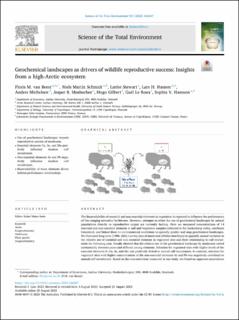| dc.contributor.author | van Beest, Floris | |
| dc.contributor.author | Schmidt, Niels Martin | |
| dc.contributor.author | Stewart, Lærke Søndergaard | |
| dc.contributor.author | Hansen, Lars H. | |
| dc.contributor.author | Michelsen, Anders | |
| dc.contributor.author | Mosbacher, Jesper Bruun | |
| dc.contributor.author | Gilbert, Hugo | |
| dc.contributor.author | Le Roux, Gaël | |
| dc.contributor.author | Hansson, Sophia V. | |
| dc.date.accessioned | 2024-04-17T12:39:39Z | |
| dc.date.available | 2024-04-17T12:39:39Z | |
| dc.date.created | 2023-09-11T14:03:52Z | |
| dc.date.issued | 2023 | |
| dc.identifier.citation | van Beest, F. M., Schmidt, N. M., Stewart, L., Hansen, L. H., Michelsen, A., Mosbacher, J. B., Gilbert, H., Le Roux, G., & Hansson, S. V. (2023). Geochemical landscapes as drivers of wildlife reproductive success: Insights from a high-Arctic ecosystem. Science of The Total Environment, 903, Artikkel 166567. | en_US |
| dc.identifier.issn | 0048-9697 | |
| dc.identifier.uri | https://hdl.handle.net/11250/3127053 | |
| dc.description.abstract | The bioavailability of essential and non-essential elements in vegetation is expected to influence the performance of free-ranging terrestrial herbivores. However, attempts to relate the use of geochemical landscapes by animal populations directly to reproductive output are currently lacking. Here we measured concentrations of 14 essential and non-essential elements in soil and vegetation samples collected in the Zackenberg valley, northeast Greenland, and linked these to environmental conditions to spatially predict and map geochemical landscapes. We then used long-term (1996–2021) survey data of muskoxen (Ovibos moschatus) to quantify annual variation in the relative use of essential and non-essential elements in vegetated sites and their relationship to calf recruitment the following year. Results showed that the relative use of the geochemical landscape by muskoxen varied substantially between years and differed among elements. Selection for vegetated sites with higher levels of the essential elements N, Cu, Se, and Mo was positively linked to annual calf recruitment. In contrast, selection for vegetated sites with higher concentrations of the non-essential elements As and Pb was negatively correlated to annual calf recruitment. Based on the concentrations measured in our study, we found no apparent associations between annual calf recruitment and levels of C, Mn, Co, Zn, Cd, Ba, Hg, and C:N ratio in the vegetation. We conclude that the spatial distribution and access to essential and non-essential elements are important drivers of reproductive output in muskoxen, which may also apply to other wildlife populations. The value of geochemical landscapes to assess habitat-performance relationships is likely to increase under future environmental change. | en_US |
| dc.language.iso | eng | en_US |
| dc.rights | Navngivelse 4.0 Internasjonal | * |
| dc.rights.uri | http://creativecommons.org/licenses/by/4.0/deed.no | * |
| dc.title | Geochemical landscapes as drivers of wildlife reproductive success: Insights from a high-Arctic ecosystem | en_US |
| dc.type | Peer reviewed | en_US |
| dc.type | Journal article | en_US |
| dc.description.version | publishedVersion | en_US |
| dc.rights.holder | © 2023 The Author(s). | en_US |
| dc.source.volume | 903 | en_US |
| dc.source.journal | Science of the Total Environment | en_US |
| dc.identifier.doi | https://doi.org/10.1016/j.scitotenv.2023.166567 | |
| dc.identifier.cristin | 2174020 | |
| dc.source.articlenumber | 166567 | en_US |
| cristin.ispublished | true | |
| cristin.fulltext | postprint | |
| cristin.qualitycode | 2 | |

